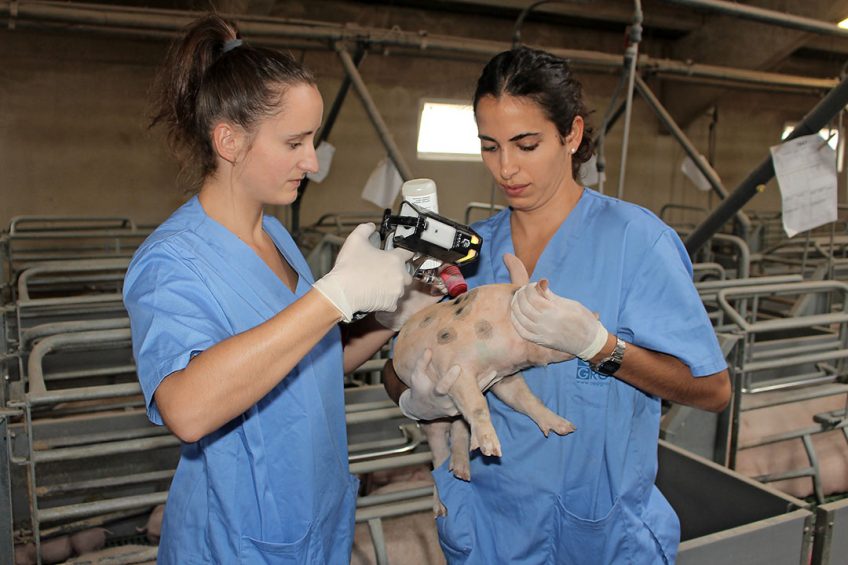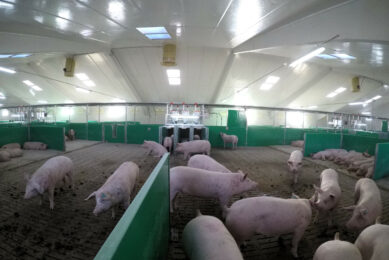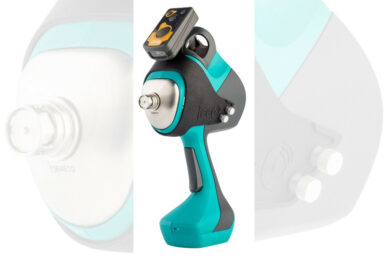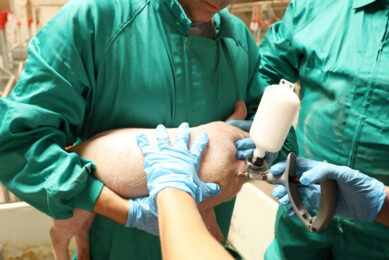Optimal Pork Production: Combining welfare with traceability

In recent years, Spain has overtaken Germany as the largest pig country in Europe. It’s not just numbers that make the difference but also the new methods of thought and technological advances that have emerged. For instance, Albesa Ramadera farm near Lleida are aiming to combine welfare with sustainability, efficiency and transparency.
Cristina Sanmartín Ruíz picks up a brown spotted piglet from the lactation pen. It squeals a bit in protest. Her colleague Laia Calderó Puig is quick and places an injector needle at the piglet’s neck. One shot, one yellow light inside the injector and one red mark on the back later, the animal is released to rejoin its littermates. Another animal protected against Porcine Circovirus, type 2. The entire procedure only takes a few seconds.
Does that all sound familiar? No doubt virtually every aspect is common practice for veterinarians and pig farmers. Except… perhaps for that yellow light? Yet that light is part of the reason for this visit. The answer as to its origins and significance can be found in Lleida, Spain, at the headquarters of the OPP Group – a (veterinary) consultancy company in Catalonia, in the heart of the country’s pig production business.
Albesa Ramadera farm
OPP Group owns Albesa Ramadera farm, where the vaccination described above took place. The farm, close to Lleida, northern Spain, is an initiative that came to life in 2009 when OPP founder and CEO Joan Sanmartín Suñer decided to put his money where his mouth is. Quite often the veterinarian advised farmers about the importance of concepts like traceability, transparency and welfare – and often the reaction he received was: ‘why don’t you try it yourself?’
|
Dr Sanmartín explains, “OPP is short for ‘Optimal Pork Production’. The word ‘pork’ in there is on purpose – we don’t mean to write ‘Pig’ in this abbreviation. Because I feel we are not producers of pigs, but we are part of the end product in the supermarket. I’m convinced that the consumer of the future will increasingly choose on the basis of production system that is used. You can compare it to good restaurants willing to work with an open kitchen, showing the cooking. A similar kind of transparency is going to totally change the pig industry of the future.”
Dr Sanmartín speaks of ‘pioneering work’, when describing the construction of Albesa Ramadera – aimed at demonstrating how transparency and welfare can be combined with efficiency and productivity. He says, “We did not want to build a traditional farm. We wanted to be able to invite people, to allow them to give in-house trainings. It was a move to a different level.”
Group housing with viewing gallery
What emerged was a 3,310 sow farrow-to-wean facility which features large, open group housing facilities for gestating sows. From a viewing gallery above, the vast pig house can be admired to its full extent. Sows as far as the eye can see, resting in tranquillity – some alone, others next to or half on top of each other. The odd animal is making a stroll and a few are waiting at the entrance of the Electronic Sow Feeding (ESF) stations.
Equally interesting is the on-site pharmacy: A very well organised room with, as a room divider in the middle, an open cupboard with neatly sorted all types of animal health products that do not need cooling.

Ricardo Segundo Cochran, training manager at OPP, explains: “We have evolved our concept of pharmacy management, since we built this farm in 2009. We conceived the veterinary on-farm pharmacy, to allow for an electronic certification. This is; the animal health products are being physically introduced to the farm, placed in the deposit, and recorded in the software. From there, they are moved on a weekly basis to pass through shelves to the pharmacy, where the farm employees use them.”
OPP is short for ‘Optimal Pork Production’. The word ‘pork’ in there is on purpose – we don’t mean to write ‘Pig’ in this abbreviation. Because I feel we are not producers of pigs, but we are part of the end product in the supermarket.” – Dr Sanmartín
Farm’s Mother
Yet, what makes the farm and it’s owning company OPP doubly interesting is the development of an underlying philosophy and working method. After all, attention for aspects like welfare and transparency are one thing to achieve – but how to prove these aspects beyond doubt at the end of the day? And how to still keep things simple?
To this end, OPP hired a great number of developers and data experts to develop a management software system that is called ‘Farm’s Mother’ – a web based system designed to be the mother of all existing systems. Feeding, environment, pig health, transport – the list of apps, sensors and computer-driven devices is growing, yet Farm’s Mother is designed to bring it back to one interface. Currently, the system is available in Spanish, Catalan, Portuguese, Polish and English – with undoubtedly more to follow. OPP reached out to a great number of companies in the international business, some of which actively cooperate and interact with the open platform, including Skov, MIK and Schauer.

Vaccination system
To dive a bit deeper, it is interesting to zoom in on the animal health side of the OPP approach. The company was looking for a system that could answer essential questions as to which vaccines and antibiotics are being given, to which animals, by whom, in what time span and how much is left of everything. Several companies are currently marketing intelligent devices that often support the tracking of their own products. Yet no swine farm uses products from only one animal health company. In addition, Farm’s Mother was looking for a system that could be integrated in to their own.
OPP therefore turned to German syringe manufacturer Henke-Sass, Wolf (HSW) to jointly embark on the design of a new concept, called the V-Etic. This add-on low frequency ID (LFID) module, which works with any HSW Eco-Matic syringe (from 0.1 ml to 5 ml). It allows veterinarians to record every animal health related injection, using Bluetooth and an app on a mobile phone or a handheld device.

The end of the module lights up dark blue when it is searching for ear tags or corresponding location tags (in farrowing rooms) – and this colour changes to a softer shade of blue when a sow has been detected. The injection follows and the module changes colour to green for a successful operation.
By aiming for a location tag rather than an ear tag, it is possible to use the same system for piglets as well. As soon as more than one injection is given with the same tag, the system knows this is because the operator has started working with piglets. Every successful injection will therefore be confirmed with the end of the module showing a yellow light – which indeed is the yellow light addition from the initial paragraph.

Vaccination process
Back to the vaccination process from the initial paragraph. Once Laia Calderó Puig has returned to the farm office, she can synchronise her PCV2 vaccination data with the V-Etic management programme. Basically everything there is to know about this particular vaccination appears on-screen and data can be fragmented, analysed or summarised in any way desired, which also includes details like how long each worker took for the vaccination or e.g. expiry date of certain products used. Endless different types of reports can thus be generated, for instance to comply with government requests for an overview of available stocks or, in case of antibiotics, about usage and withdrawal times. As practical advantages, she mentions a vastly reduced volume of paperwork as well as a higher level of accuracy, which in turn will avoid mistakes.
While the V-Etic system can also be used as a stand-alone application on any farm worldwide, OPP is aiming for further optimisation of the system within its own Farm’s Mother overhead programme. The company is now developing artificial intelligence modules to make sure that farmers will be able, amidst piles of generated data, to extract the figures that are important for them to know.

Technology and welfare
Summarising – ten years of combining technology and welfare, how does owner Dr Sanmartín Suñer look back on these developments? He says, “The system Farm’s Mother has helped management of Albesa as well as other technological farms we constructed in different ways:
- First it interconnects the software of the feeding system with the management software, synchronising all information of the farm.
- Secondly it brought us new parameters of piglet feed efficiency based on precise sow feed efficiency calculations.
- Thirdly, it is probably the first web based platform that allows you to navigate from reports to individuals.
- Fourth – it contains specific models for integration managers, which allows the ranking of farms according to certain parameters.”
So all in all, is he proud of all these developments? Dr Sanmartín Suñer says, “Yes. We have chosen a technological road that responds best to animal welfare requests. Not only because animal welfare brings health and productivity goals, but also because it addresses the more stringent consumer requests of new generations. I am convinced that the Albesa Ramadera farm is the first farm of a new generation that managed to harmoniously balance animal welfare, technology, efficiency and sustainability.”
Optimal Pork ProductionThe veterinary consultancy company Optimal Pork Production (OPP) has been existing since 1997. From being a veterinary-only company, over the years, OPP developed itself to get involved in other aspects of pig production, like management, farm design of pig house buildings and staff training, believing that good health and welfare start with a good basic philosophy at the start. Currently the company is active in 28 projects in eight countries worldwide, apart from Spain including e.g. Canada, Brazil, Mexico and Argentina. |


 PROFILE
PROFILE











